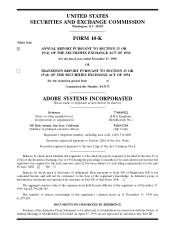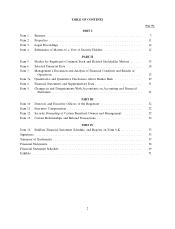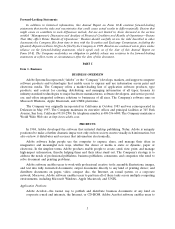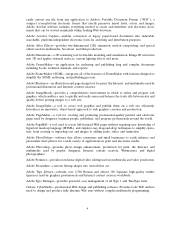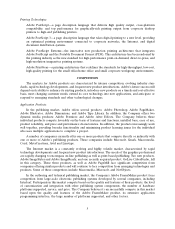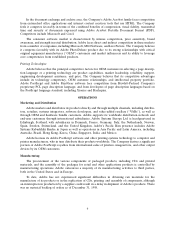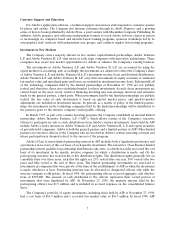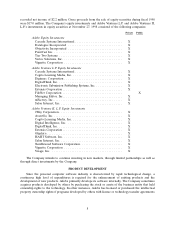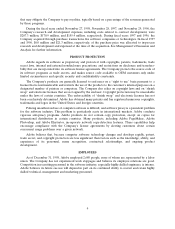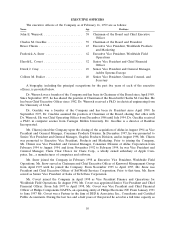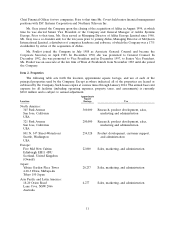Adobe 1998 Annual Report Download - page 9
Download and view the complete annual report
Please find page 9 of the 1998 Adobe annual report below. You can navigate through the pages in the report by either clicking on the pages listed below, or by using the keyword search tool below to find specific information within the annual report.that may obligate the Company to pay royalties, typically based on a percentage of the revenues generated
by those programs.
During the fiscal years ended November 27, 1998, November 28, 1997, and November 29, 1996, the
Company’s research and development expenses, including costs related to contract development, were
$207.3 million, $170.9 million, and $155.4 million, respectively. During fiscal years 1997 and 1996, the
Company acquired through purchase transactions five software companies or technologies. In fiscal 1997
and 1996, $6.0 million and $21.3 million, respectively, of the purchase price was allocated to in-process
research and development and expensed at the time of the acquisition. See Management’s Discussion and
Analysis for further information.
PRODUCT PROTECTION
Adobe regards its software as proprietary and protects it with copyrights, patents, trademarks, trade
secret laws, internal and external nondisclosure precautions, and restrictions on disclosure and transfera-
bility that are incorporated into its software license agreements. The Company protects the source code of
its software programs as trade secrets, and makes source code available to OEM customers only under
limited circumstances and specific security and confidentiality constraints.
The Company’s products are generally licensed to end users on a ‘‘right to use’’ basis pursuant to a
license that is nontransferable and restricts the use of the products to the customer’s internal purposes on a
designated number of printers or computers. The Company also relies on copyright laws and on ‘‘shrink
wrap’’ and electronic licenses that are not signed by the end user. Copyright protection may be unavailable
under the laws of certain countries. The enforceability of ‘‘shrink wrap’’ and electronic licenses has not
been conclusively determined. Adobe has obtained many patents and has registered numerous copyrights,
trademarks and logos in the United States and foreign countries.
Policing unauthorized use of computer software is difficult, and software piracy is a persistent problem
for the software industry. This problem is particularly acute in international markets. Adobe conducts
vigorous anti-piracy programs. Adobe products do not contain copy protection, except on copies for
international distribution in certain countries. Many products, including Adobe PageMaker, Adobe
Photoshop, and Adobe Illustrator, incorporate network copy-detection features. These capabilities help
encourage compliance with the Company’s license agreements by alerting customers about certain
concurrent usage problems over a given network.
Adobe believes that, because computer software technology changes and develops rapidly, patent,
trade secret, and copyright protection are less significant than factors such as the knowledge, ability, and
experience of its personnel, name recognition, contractual relationships, and ongoing product
development.
EMPLOYEES
As of December 31, 1998, Adobe employed 2,680 people, none of whom are represented by a labor
union. The Company has not experienced work stoppages and believes its employee relations are good.
Competition in recruiting personnel in the software industry, especially highly skilled engineers, is intense.
Adobe believes its future success will depend in part on its continued ability to recruit and retain highly
skilled technical, management and marketing personnel.
9

